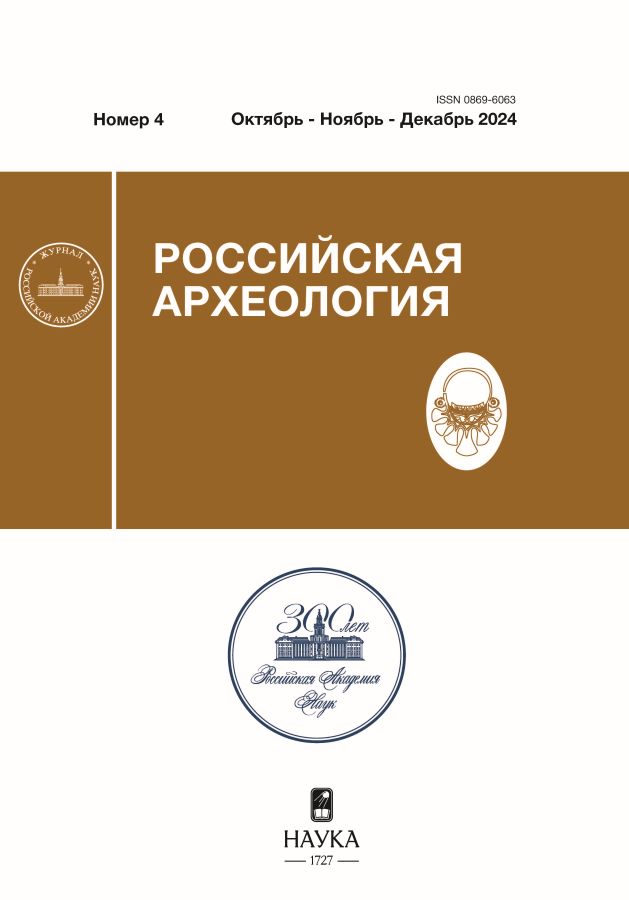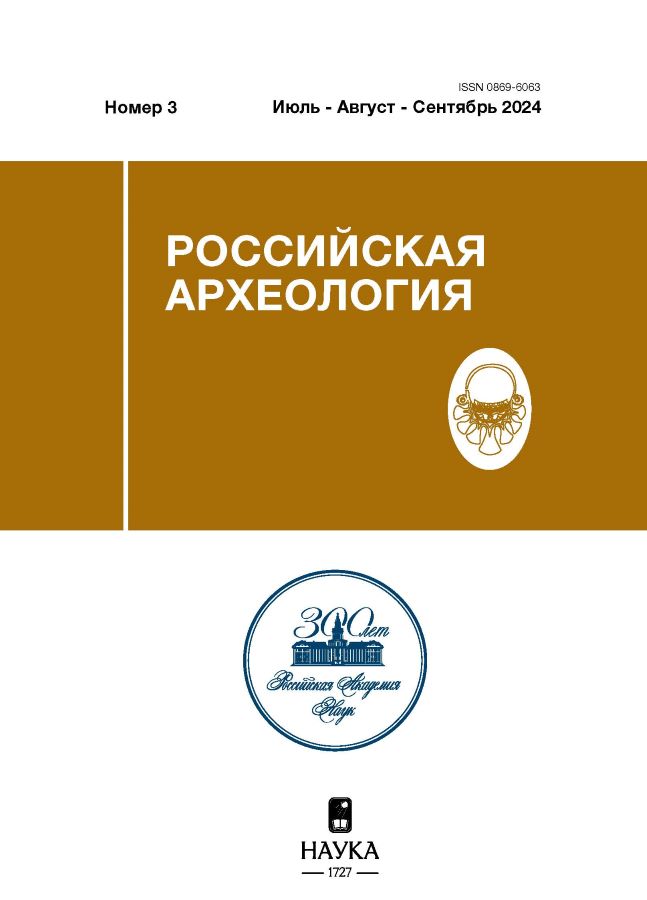New data to determine the Nature of food in the vessels from the classical burial Ground of Volna 1
- Authors: Plekhanova L.N.1, Kashirskaya N.N.1, Mimokhod R.A.2, Sudarev N.I.2
-
Affiliations:
- Institute of Physicochemical and Biological Problems of Soil Science RAS
- Institute of Archaeology RAS
- Issue: No 3 (2024)
- Pages: 101-116
- Section: ARTICLES
- URL: https://permmedjournal.ru/0869-6063/article/view/655753
- DOI: https://doi.org/10.31857/S0869606324030071
- EDN: https://elibrary.ru/XADWTJ
- ID: 655753
Cite item
Abstract
Soil samples were taken from the bottom layer of several vessels (an amphora, a red clay jug, and two oinochoai) from the classical burial ground of Volna 1 on the Taman Peninsula in order to develop approaches to determining the composition of ritual food. Microbiological and enzymological traces indicating initial organic substrates in the vessels were studied. By planting an aqueous suspension of soil on solid nutrient media, the number of trophic groups of microorganisms associated with the initial presence of food in burial vessels was determined. Microorganisms that assimilate organic matter, fats, starch and protein were evaluated. Live cultures of lactic acid bacteria were isolated from all vessels, and micrographs of them with the shape of cells and colonies were obtained for the first time. They differed in their growth rate and the rate of fermentation of substrates such as milk and simple sugars. Genetic identification of a microorganism found in the oinochoai from burial 370 by genus Sporolactobacillus as the closest to the typical Sporolactobacillus pectinivorans strain with a similarity level of 97.55% makes it possible to discuss interpretations assuming the original presence of funeral food in the ancient vessel in the form of raw milk with sugar syrup. Other lactobacilli were also found in the vessels.
Full Text
About the authors
Lyudmila N. Plekhanova
Institute of Physicochemical and Biological Problems of Soil Science RAS
Author for correspondence.
Email: dianthus1@rambler.ru
Russian Federation, Pushchino
Natalya N. Kashirskaya
Institute of Physicochemical and Biological Problems of Soil Science RAS
Email: nkashirskaya81@gmail.com
Russian Federation, Pushchino
Roman A. Mimokhod
Institute of Archaeology RAS
Email: mimokhod@gmail.com
Russian Federation, Moscow
Nikolay I. Sudarev
Institute of Archaeology RAS
Email: sudarev@list.ru
Russian Federation, Moscow
References
- Aleksandrovskiy A.L., Aleksandrovskaya E.I., 1999. Determining the contents of vessels from burials of the Bronze Age – Early Iron Age in the Mandzhikiny-1 burial ground. Mogil'nik Mandzhikiny-1: pamyatnik epokhi bronzy – rannego zheleznogo veka [The Mandzhikiny-1 burial ground: an archaeological site of the Bronze Age – Early Iron Age]. Moscow: Gosudarstvennyy istoricheskiy muzey; Elista: Kalmytskiy institut sotsial'no-ekonomicheskikh i pravovykh issledovaniy, pp. 48–49. (In Russ.)
- Antonaccio C.M., 1995. An archaeology of ancestors: tomb cult and hero cult in early Greece. Maryland: Rowman & Littlefield. 308 p.
- Balonov F.R., 1994. A pectoral from Tolstaya Mogila as a model of mythopoetic space-time. Elitnye kurgany stepey Evrazii v skifo-sarmatskuyu epokhu [Elite mounds of the Eurasian steppes in the Scythian-Sarmatian period]. St. Petersburg, pp. 17–23. (In Russ.)
- Beazley Archive Pottery Database (BAPD) – Pouring vessels (Electronic resource). URL: https://www.carc.ox.ac.uk/carc/resources/Introduction-to-Greek-Pottery/Shapes/Pouring-vessels.
- Bérard R.-M., 2017. Mégara Hyblaea, 6. La nécropole méridionale de la cité archaïque, 2. Archéologie et histoire sociale des rituels funéraires. Rome: École française de Rome. 365 p.
- Blavatskiy V.D., 1953. Istoriya antichnoy raspisnoy keramiki [History of classical painted pottery]. Moscow: Izdatel'stvo Moskovskogo universiteta. 303 p.
- Burkert W., 1983. Homo Necans. The Anthropology of Ancient Greek Sacrificial Ritual and Myth. Berkeley; Los Angeles; London: University of California Press. 335 p.
- De Man J.C., Rogosa M., Sharpe M.E., 1960. A medium for the cultivation of lactobacilli. Journal of applied Bacteriology, vol. 23, no. 1, pp. 130–135.
- Demkin V.A., Demkina T.S., 2000. Possibilities for reconstructing burial food in ceramic vessels from burial mounds of the Bronze and Early Iron Ages. Etnograficheskoe obozrenie [Ethnographic review], 4, pp. 73–81. (In Russ.)
- Demkin V.A., Demkina T.S., Udal'tsov S.N., 2014. Reconstruction of burial food in clay vessels from mound burial sites using phosphate and microbiological methods. Vestnik arkheologii, antropologii i etnografii [Vestnik Arheologii, Antropologii i Etnografii], 2 (25), pp. 148–159. (In Russ.)
- Dentzer J.-M., 1982. Le motif du banquet couché dans le Proche-Orient et le monde grec du VIIe au IVe siècle avant J.-C. Rome: École française de Rome. 673 p.
- Dubois C., 2012. Des objets pour les bébés? Le dépôt de mobilier dans les sépultures d'enfants en bas âge du monde grec archaïque et classique. L’enfant et la mort dans l’Antiquité III. Le matériel associé aux tombes d’enfants: Actes de la table ronde internationale organisée à la Maison méditerranéenne des sciences de l’homme (MMSH) d’Aix-en-Provence, 20–22 janvier 2011. Aix-en-Provence, pp. 329–342.
- Elliker P.R., Anderson A.W., Hannesson G., 1956. An Agar Culture Medium for Lactic Acid Streptococci and Lactobacilli. Journal of dairy science, vol. 39, iss. 11, pp. 1611–1612.
- Faraone C., 2011. Rushing into milk: New perspectives on the gold tablets. The “Orphic” gold tablets and Greek religion. Cambridge: Cambridge University Press, pp. 310–330.
- Gaifman M., 2018. The Greek libation bowl as embodied object. Art History, vol. 41, no. 3, pp. 444–465.
- Garland R., 1985. The Greek Way of Death. New York: Cornell University Press. 224 p.
- Gayduchenko L.L., Zdanovich D.G., 2002. Food burns on vessels from mound 25 of the Bolshekaragansky burial ground. Arkaim: nekropol' (po materialam kurgana 25 Bol'shekaraganskogo mogil'nika) [Arkaim: the necropolis (based on materials from mound 25 of the Bolshekaragansky burial ground)], 1. Chelyabinsk: Yuzhno-Ural'skoe knizhnoe izdatel'stvo, pp. 120–128. (In Russ.)
- Heatmapper. Expression (Electronic resource). URL: http://www.heatmapper.ca/expression/.
- Holliday V.T., Gartner W.G., 2007. Methods of soil P analysis in archaeology. Journal of Archaeological Science, vol. 34, iss. 2, pp. 301–333.
- Jaeggi S., Whittmann A., Garnier N., Frère D., 2015. Biberon or not biberon? Les analyses biochimiques de contenus et la question de la fonction de vases gallo-romains communément appelés “biberons”. Actes Du Congrès de Nyon. Marseille: Société Française d'Étude de la Céramique Antique en Gaule, pp. 561–576.
- Jameson M.H., Jordan D.R., Kotansky R.D., 1993. A Lex Sacra from Selinous. Durham, NC: Duke University. 211 p. (Greek, Roman, and Byzantine Monographs, 11).
- Kashirskaya N.N., Plekhanova L.N., Petrosyan A.A., Potapova A.V., Syrovatko A.S, Kleshchenko A.A., Borisov A.V., 2018. Approaches to identifying wool products based on the number of keratinolytic microorganisms in the soils of ancient and medieval burials. Nizhnevolzhskiy arkheologicheskiy vestnik [The Lower Volga Archaeological Bulletin], vol. 17, no. 2, pp. 95–107. (In Russ.)
- Kotwick M.E., 2017. Der Papyrus von Derveni: griechisch-deutsch. Berlin: Walter de Gruyter. 383 p.
- Kurtz D.C., Boardman J., 1971. Greek Burial Customs. London Thames and Hudson. 384 p.
- Lan Q, Chen J., Lin L., Ye X., Yan Q., Huang J., Liu C., Yang G., 2016. Sporolactobacillus pectinivorans sp. nov., an anaerobic bacterium isolated from spoiled jelly. International Journal of Systematic and Evolutionary Microbiology, vol. 66, iss. 11, pp. 4323–4328.
- Matveeva N.P., Larina N.S., Rafikova T.N., 2007. Study of the food of the medieval population in the forest Trans-Urals based on food burns on the ware. Vestnik arkheologii, antropologii i etnografii [Vestnik Arheologii, Antropologii i Etnografii], 8, pp. 110–119. (In Russ.)
- Mimokhod R.A., Sudarev N.I., Uspenskiy P.S., 2018а. Research at the Volna 1 burial ground in 2017. Prichernomor'e v antichnoe i rannesrednevekovoe vremya [The Pontic region in the classical and early medieval periods], 2. Sbornik nauchnykh trudov, posvyashchennyy 70-letiyu professora V.P. Kopylova [Collected works to the 70th anniversary of Professor V.P. Kopylov]. Rostov-na-Donu, pp. 120–144. (In Russ.)
- Mimokhod R.A., Sudarev N.I., Uspenskiy P.S., 2018б. The Volna-1 necropolis (2017) (Krasnodar Territory, Taman Peninsula). Goroda, selishcha, mogil'niki. Raskopki 2017 [Towns, villages, burial grounds. Excavations of 2017]. Moscow: Institut arkheologii Rossiyskoy akademii nauk, pp. 220–231. (Materialy spasatel'nykh arkheologicheskikh issledovaniy, 25). (In Russ.)
- Monakhov S.Yu., 2003. Grecheskie amfory v Prichernomor'e. Tipologiya amfor vedushchikh tsentrov-eksporterov tovarov v keramicheskoy tare: katalog-opredelitel' [Greek amphorae in the Pontic region. Typology of amphorae from leading centres exporting goods in ceramic containers: a guide-catalogue]. Moscow; Saratov: Kimmerida: Izdatel'stvo Saratovskogo gosudarstvennogo universiteta. 352 p.
- National Center for Biotechnology Information (NCBI) – Gen Bank (Electronic resource). URL: https://www.ncbi.nlm.nih.gov/genbank/.
- Papanova V.A., 1997. Wake rite of the Olbian citizens. Nikoniy i antichnyy mir Severnogo Prichernomor'ya [Nikonion and the classical world of the Northern Pontic]. Odessa, pp. 156–161. (In Russ.)
- Papanova V.A., 2006. Urochishche Sto mogil – nekropol' Ol'vii Pontiyskoy [The Sto Mogil site – the necropolis of Pontic Olbia]. Kiev: Znaniya Ukrainy. 278 p.
- Pedrucci G., 2015. Baliatico αἰδώς e malocchio: capire l'allattamento nella Grecia di epoca arcaica e classica anche con l'aiuto delle fonti romane. EuGeStA, 5, pp. 27–53.
- Pedrucci G., 2018. L’ambiguità del latte, bevanda dei morti nel mondo greco. Archeologia e antropologia della morte, 2. Corpi, relazioni e azioni: il paesaggio del rito: Atti del 3° Incontro Internazionale di Studi di Antropologia e archeologia a confronto. V. Nizzo, ed. Roma: Edipuglia, pp. 735–740, 812.
- Piano V., 2016. Il Papiro di Derveni tra religione e filosofia. Firenze: Leo S. Olschki. 442 p. (Studi e Testi per il Corpus dei Papiri Filosofici Greci e Latini, 18).
- Plekhanova L.N., 2018. Cellulase activity in anthropogenically disturbed chernozems. 18th International Multidisciplinary Scientific GeoConference, 5.2. Sofia, pp. 173–180.
- doi: 10.5593/sgem2018/5.2.
- Plekhanova L.N., Kashirskaya N.N., Syrovatko A.S., 2020. Cellulosolitic microorganisms activity as an indicator of details in funeral ceremony. Nizhnevolzhskiy arkheologicheskiy vestnik [The Lower Volga Archaeological Bulletin], vol. 19, no. 1, pp. 116–129. (In Russ.)
- Plekhanova L.N., Udaltsov S.N., Syrovatko A.S., Kashirskaya N.N., 2023. Low Activity Forms of Cellulosolitic Microorganisms in Archaeological Contexts. Biophysics, vol. 68, no. 5, pp. 823–830.
- Pomadère M., 2007. Des enfants nourris au biberon à l’Âge du Bronze. Cooking up the past: food and culinary practices in the Neolithic and Bronze Age Aegean. Oxford: Oxbow Books, pp. 270–309.
- Soberl L., 2011. Pots for the afterlife: organic residue analysis of British early Bronze age pottery from funerary contexts: PhD dissertation, University of Bristol. Bristol. 296 p.
- Soyer K., 1977. Phosphorus and ecology. Fosfor v okruzhayushchey srede [Phosphorus in the environment]. Moscow: Mir, pp. 688–705. (In Russ.)
- Stengel P., 1880. Totenspenden. Philologus, 39, pp. 378–381.
- Terzaghi B.E., Sandine W.E., 1975. Improved Medium for Lactic Streptococci and Their Bacteriophages. Applied Microbiology, vol. 29, no. 6, pp. 807–813.
- Tsetskhladze G., 2015. Greek pottery and transportation amphorae in the Pontic hinterland: how and why. Bosporskie issledovaniya [Bosporan studies], 31. Simferopol'; Kerch', pp. 60–87. (In Russ.)
- Tsokur I.V., Sudarev N.I., Sharov O.V., 2022. Volna 1. Nekropol' arkhaicheskogo – ellinisticheskogo periodov na Tamanskom poluostrove [Volna 1. A necropolis of the archaic – Hellenistic periods on the Taman Peninsula], 1. Moscow: Institut arkheologii Rossiyskoy akademii nauk. 400 p. (Materialy spasatel'nykh arkheologicheskikh issledovaniy, 30).
- Zanina O.G., Tishkin A.A., Khodzhaeva A.K., Demkin V.A., 2013. Results of phosphate and biomorphic analyses of the soil filling of a vessel from mound 4 in the Bugry site (northwestern foothills of Altai). Teoriya i praktika arkheologicheskikh issledovaniy [Theory and practice of archaeological research], 1 (7), pp. 125–134. (In Russ.).
Supplementary files

















